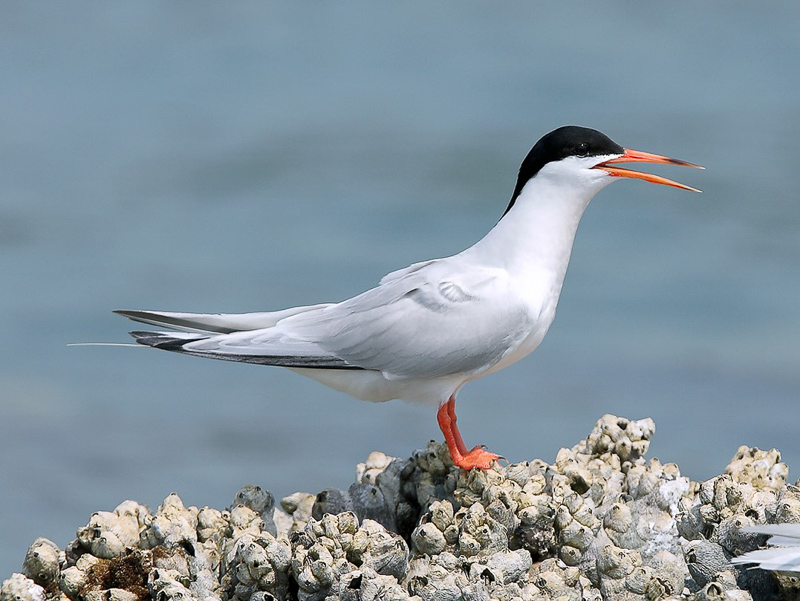Roseate Tern Sterna dougallii 粉紅燕鷗
Category I. Locally common summer visitor usually seen breeding islets in eastern waters.
IDENTIFICATION

May 2023, Caius Cheung. Adult early breeding season.
33-41 cm. Medium-sized tern that is overall very pale. Adult breeding is very pale grey above with the black cap reaching far down the nape, a long deeply-forked tail and orange legs. Early in the breeding season the bill may be blackish or blackish-red and a roseate flush may pervade the fore neck, chest and upper belly.

Jul. 2008, Michelle and Peter Wong. Adult, late breeding season.
33-41 cm. Later in the breeding season the bill is reddish, often with any black largely on the upper mandible.
In non-breeding plumage (rarely seen in HK) a black mask reaches back from the eye to the nape and the tail is shorter. Sexes not generally separable, though female may appear slightly larger.

Jul. 2021, Michelle and Peter Wong. Adult late breeding season.
In flight the outermost primaries are darker and contrast with the overall pale upperwings and mantle.

Aug. 2021, Martin Hale. Juvenile.
Juveniles have dark crown, nape and area behind eye (but no obvious mask), broad grey-brown bars on mantle and scapulars with relatively little pale grey visible, rather pale wing coverts with limited dark areas except when very fresh and a clear-cut whitish inner edge to the primaries visible in closed wing at rest. Care needed in separating from juvenile Black-naped Tern.
VOCALISATIONS
Calls are generally not as high-pitched as Black-naped Tern. The advertising call given by adults when carrying fish is a disyllabic ‘kyi-vik’.
Juvenile calls are similar to other Sterna terns.
DISTRIBUTION & HABITAT PREFERENCE
All records of Roseate Tern have occurred at sea in both inshore and offshore waters or on small islands, usually at breeding colonies. There are no inland records.
OCCURRENCE
Roseate Tern was added to the HK list when a breeding pair was discovered in a colony of Black-naped Terns on Shek Ngau Chau, Mirs Bay on 8 June 1985 (Chalmers 1987). It was subsequently established that it was a scarce summer visitor to isolated offshore islets. Earlier records that subsequently came to light concerned 16 adults with four probable juveniles on 7 September 1978 and two adults on 7 September 1979.
Generally Roseate Terns arrive late in spring. Although the earliest on record occurred on 2 April 2019 (when a total of 20 birds were recorded in eastern HK waters), there are relatively few records until 29 April, which is a more typical date of earliest arrival. A bird in first-summer plumage south of HK Island on 29 September 1993 remains the latest record, while the latest since 1999 occurred on 3 September.
Two birds seen in eastern waters on 2 August 2010 bore leg flags attached at Swain Reef, Great Barrier Reef, Queensland, Australia (6,391 km distant), where they had been flagged as adults in January or February in the period after 2002.
BEHAVIOUR, FORAGING & DIET
Forages on small fish.
BREEDING
Since 2011 annual surveys have been carried out of the breeding population of terns in HK. Surveys are made from moving boats that are often unable to make a close approach due to sea conditions, which makes it difficult to collect accurate data on the number of pairs or juveniles on or near the nest. From 2011 to 2021 the peak annual count of birds at breeding colonies varied from 79 to 531 (mean 399) (AFCD in litt.).
The nesting period, which lasts from the final week of May to the third week of August, is shorter than that of other breeding terns in HK. The Ninepins has traditionally supported the highest number of breeding birds.
Juveniles appear to move away from the breeding sites to adjacent feeding areas shortly after fledging, which occurs between mid-July and mid-August, and are then easily overlooked.
RANGE & SYSTEMATICS
Breeds largely in tropical and subtropical seas around the world, but also extends north to the U.K. and south to South Africa; winters in seas off the coast of northeast South America, west, south and southeast Africa and tropical waters of southeast Asia and northern Australia (Gochfeld and Burger 2020). In China a summer visitor to East and South China Sea coastal areas (Liu and Chen 2020).
Polytypic. The taxon occurring in HK is S. d. bangsi, which breeds in the east Indian and west Pacific Oceans.
CONSERVATION STATUS
IUCN: Least Concern. Population trend unknown.
Chalmers, M. L. (1987). Records Committee Report 1985. Hong Kong Bird Report 1984/85: 32-47.
Gochfeld, M. and J. Burger (2020). Roseate Tern (Sterna dougallii), version 1.0. In Birds of the World (S. M. Billerman, Editor). Cornell Lab of Ornithology, Ithaca, NY, USA. https://doi.org/10.2173/bow.roster.01
Liu, Y. and Y. H. Chen (eds) (2020). The CNG Field Guide to the Birds of China (in Chinese). Hunan Science and Technology Publication House, Changsha.

